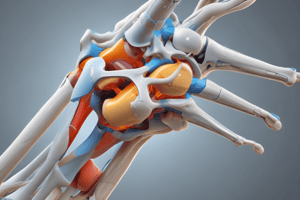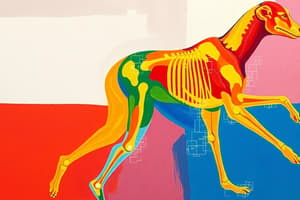Podcast
Questions and Answers
What type of movement occurs when a convex member rolls and slides in opposite directions on a concave surface?
What type of movement occurs when a convex member rolls and slides in opposite directions on a concave surface?
- Spin arthrokinematics
- Roll and slide in similar directions
- No movement occurs
- Roll and slide in opposite directions (correct)
In arthrokinematic principles, what occurs when a concave member rolls and slides in similar directions on a convex surface?
In arthrokinematic principles, what occurs when a concave member rolls and slides in similar directions on a convex surface?
- No movement occurs
- Roll and slide in similar directions (correct)
- Spin arthrokinematics
- Roll and slide in opposite directions
What happens if motion is reduced according to the text?
What happens if motion is reduced according to the text?
- Only osteokinematic motion is affected
- Both osteokinematic and arthrokinematic motions are increased
- Functional disorder occurs (correct)
- Motion can never be reduced
Which joint demonstration involves a combination of roll-and-slide with spin arthrokinematics?
Which joint demonstration involves a combination of roll-and-slide with spin arthrokinematics?
How many degrees of freedom does a joint have if it can swing in one direction or only spin?
How many degrees of freedom does a joint have if it can swing in one direction or only spin?
Which joint has 3 degrees of freedom allowing it to both spin and swing in two distinct directions?
Which joint has 3 degrees of freedom allowing it to both spin and swing in two distinct directions?
What are the three fundamental types of arthrokinematic movements that occur between curved joint surfaces?
What are the three fundamental types of arthrokinematic movements that occur between curved joint surfaces?
In arthrokinematic movements, which type of relationship can exist between two articular surfaces at a joint?
In arthrokinematic movements, which type of relationship can exist between two articular surfaces at a joint?
Which term refers to the motion where one joint surface rolls on another joint surface?
Which term refers to the motion where one joint surface rolls on another joint surface?
Which term describes the arthrokinematic motion where one joint surface slides over another?
Which term describes the arthrokinematic motion where one joint surface slides over another?
What is the direction of movement based on in arthrokinematic principles?
What is the direction of movement based on in arthrokinematic principles?
What is the example given in the text for a convex-concave relationship between two articular surfaces?
What is the example given in the text for a convex-concave relationship between two articular surfaces?
What is the term used to describe fixation of the distal segment so that joint motion takes place in multiple planes and the limb is supporting weight?
What is the term used to describe fixation of the distal segment so that joint motion takes place in multiple planes and the limb is supporting weight?
Which position involves the maximum congruity of opposing joint surfaces and is considered the most stable?
Which position involves the maximum congruity of opposing joint surfaces and is considered the most stable?
What is the term for a joint moving less than what is considered normal, or compared to the same joint on the opposite extremity?
What is the term for a joint moving less than what is considered normal, or compared to the same joint on the opposite extremity?
Which term describes all activities involving the end segment of an extremity moving freely through space?
Which term describes all activities involving the end segment of an extremity moving freely through space?
Movements away from the close-packed position of a joint involve which element?
Movements away from the close-packed position of a joint involve which element?
If a joint moves more than what is considered normal, it may be deemed:
If a joint moves more than what is considered normal, it may be deemed:
Flashcards
Convex-on-concave movement
Convex-on-concave movement
A joint movement where a convex surface rolls and slides in opposite directions on a concave surface.
Concave-on-convex movement
Concave-on-convex movement
A joint movement where a concave surface rolls and slides in similar directions on a convex surface.
Hypomobility
Hypomobility
Reduced joint movement; the joint moves less than normal.
Radio-humeral joint
Radio-humeral joint
Signup and view all the flashcards
One degree of freedom
One degree of freedom
Signup and view all the flashcards
Three degrees of freedom
Three degrees of freedom
Signup and view all the flashcards
Arthrokinematic movements
Arthrokinematic movements
Signup and view all the flashcards
Roll
Roll
Signup and view all the flashcards
Slide
Slide
Signup and view all the flashcards
Convex-concave relationship
Convex-concave relationship
Signup and view all the flashcards
Close-packed position
Close-packed position
Signup and view all the flashcards
Hypomobility
Hypomobility
Signup and view all the flashcards
Hypermobility
Hypermobility
Signup and view all the flashcards
Open-chain movement
Open-chain movement
Signup and view all the flashcards
Weight-bearing fixation
Weight-bearing fixation
Signup and view all the flashcards
Joint Movement Elements
Joint Movement Elements
Signup and view all the flashcards
Study Notes
Arthrokinematic Principles
- Convex-on-concave movement occurs when a convex member rolls and slides in opposite directions on a concave surface.
- Concave-on-convex movement occurs when a concave member rolls and slides in similar directions on a convex surface.
Joint Movements
- Reduced motion is characterized by hypomobility.
- The joint demonstration that involves a combination of roll-and-slide with spin arthrokinematics is the radio-humeral joint.
Degrees of Freedom
- A joint with one degree of freedom can swing in one direction or only spin.
- A joint with three degrees of freedom, like the shoulder joint, can spin and swing in two distinct directions.
Arthrokinematic Movements
- The three fundamental types of arthrokinematic movements that occur between curved joint surfaces are roll, slide, and spin.
Joint Relationships
- In arthrokinematic movements, a convex-concave relationship can exist between two articular surfaces at a joint.
- Rolling occurs when one joint surface rolls on another joint surface.
- Sliding occurs when one joint surface slides over another.
Arthrokinematic Directions
- The direction of movement is based on the shape and orientation of the joint surfaces.
Joint Examples
- The example of a convex-concave relationship between two articular surfaces is the shoulder joint.
Fixation
- Weight-bearing fixation occurs when the distal segment is fixed, allowing joint motion to take place in multiple planes and the limb to support weight.
Close-Packed Position
- The close-packed position of a joint involves the maximum congruity of opposing joint surfaces and is considered the most stable.
Hypomobility and Hypermobility
- Hypomobility refers to a joint moving less than what is considered normal or compared to the same joint on the opposite extremity.
- Hypermobility occurs when a joint moves more than what is considered normal.
Open-Chain Movements
- Open-chain movements describe all activities involving the end segment of an extremity moving freely through space.
Joint Movement Elements
- Movements away from the close-packed position of a joint involve the rotation of the joint surfaces.
Studying That Suits You
Use AI to generate personalized quizzes and flashcards to suit your learning preferences.




